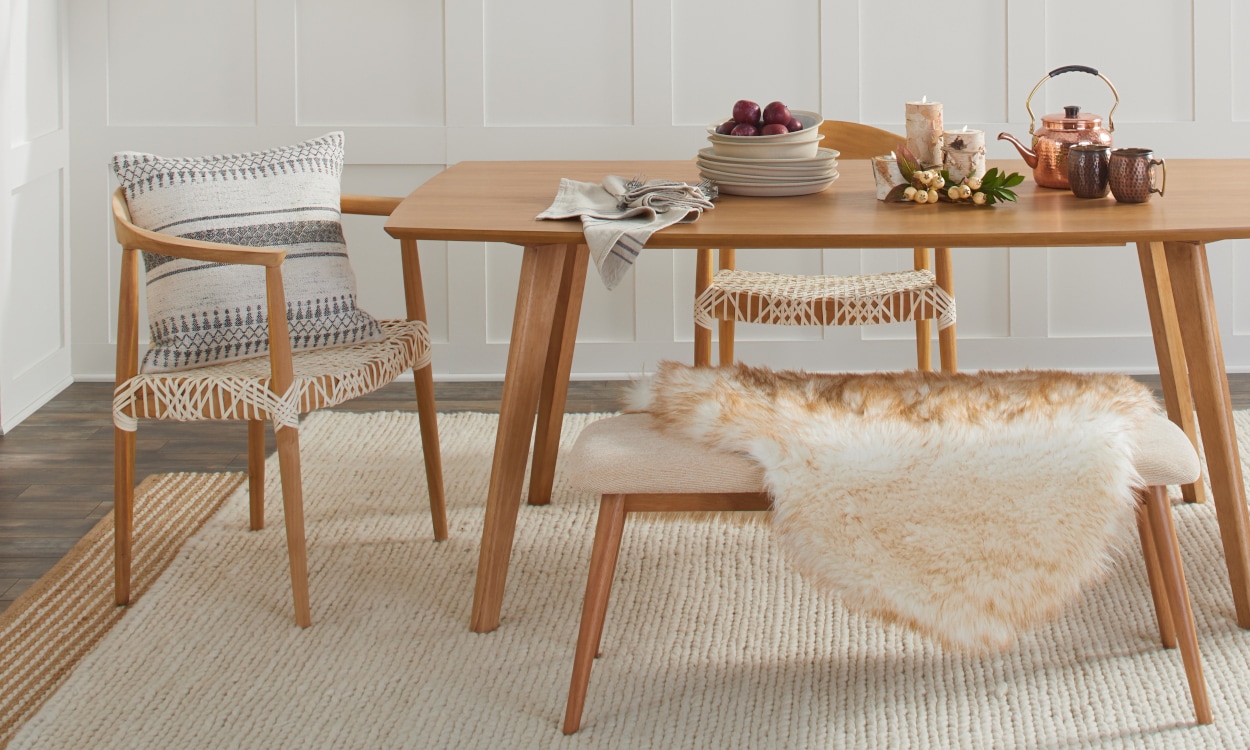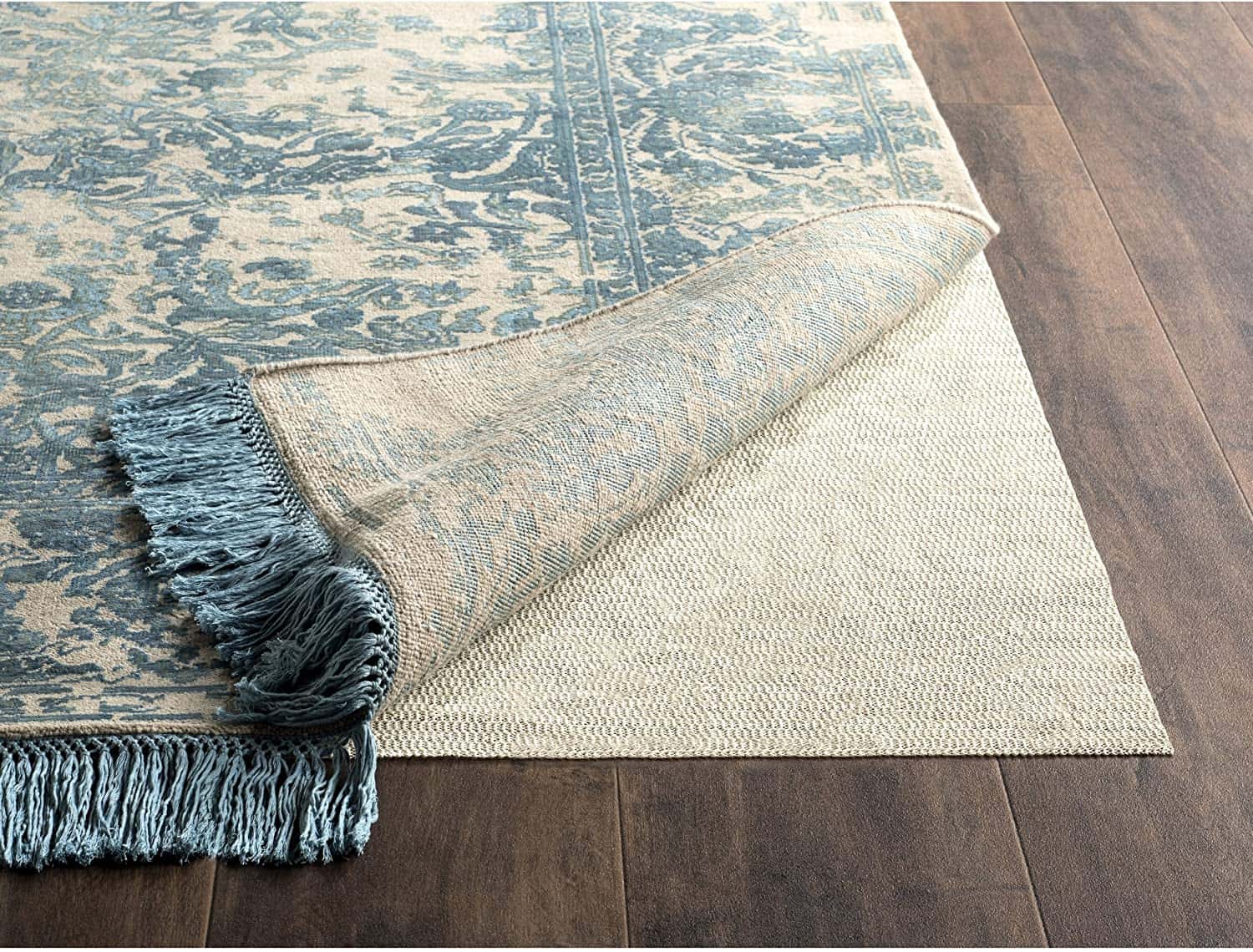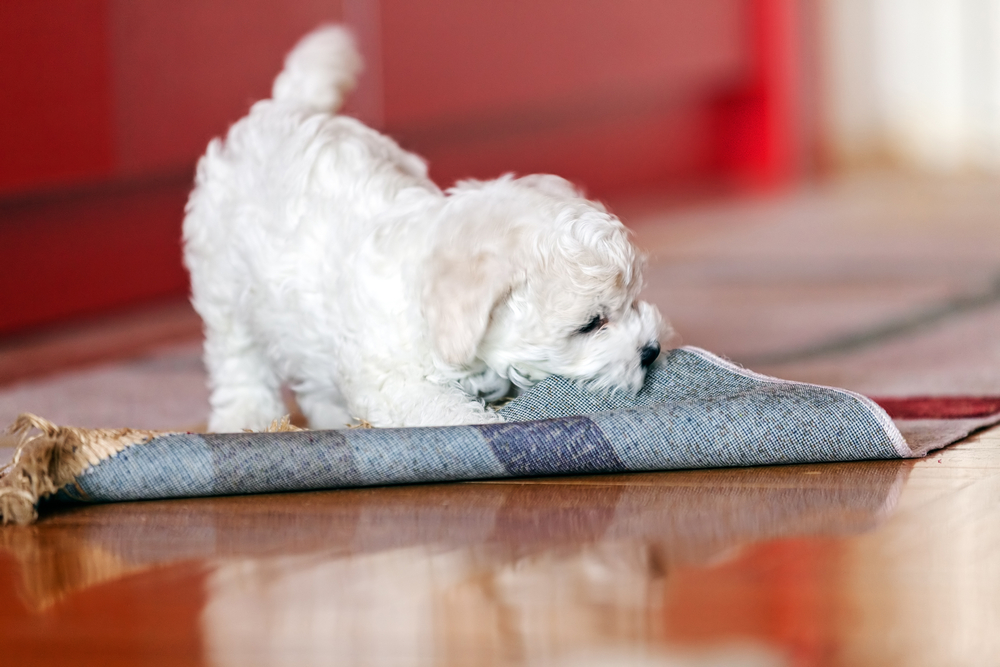Benefits of Putting a Rug Under Your Kitchen Table
Adding a rug under your kitchen table can bring numerous benefits to your space. Not only does it add a touch of style and warmth to your dining area, but it also serves a functional purpose. Here are some of the top benefits of putting a rug under your kitchen table:
1. Protects Your Flooring
One of the main advantages of using a rug under your kitchen table is that it protects your flooring. Constantly moving chairs and foot traffic can cause scratches, scuff marks, and stains on your floor. By placing a rug under your table, you create a barrier between your furniture and the floor, keeping it in good condition.
2. Defines the Space
If you have an open-concept kitchen and dining area, adding a rug under your table can help define the space. It creates a visual separation between the two areas, making your dining area feel more intimate and distinct.
3. Absorbs Noise
Hard flooring can be noisy, especially when chairs are being moved in and out constantly. A rug can help absorb some of the noise, making your dining area a more peaceful and comfortable space.
4. Adds Texture and Color
A rug can add a pop of color and texture to your kitchen space. It allows you to incorporate your personal style and tie in different elements of your décor. You can choose a rug that complements your existing color scheme or go for a bold statement piece.
5. Comfort Underfoot
Sitting at the dining table for extended periods can be uncomfortable, especially on hard flooring. A rug can provide a soft and comfortable surface underfoot, making your dining experience more enjoyable.
How to Choose the Perfect Rug for Your Kitchen Table
Now that you know the benefits of using a rug under your kitchen table, it's time to choose the perfect one for your space. Here are some factors to consider when making your decision:
1. Size
The size of your rug is crucial when placing it under a kitchen table. You want to make sure it is large enough to accommodate the table and chairs, even when they are pulled out. A general rule of thumb is to leave at least 18-24 inches of space between the edge of the rug and the surrounding furniture.
2. Shape
The shape of your rug should also complement the shape of your table. For round tables, a round or square rug would work best, while a rectangular rug would suit a rectangular table. Consider the shape of your dining area as well, and choose a rug that will fit nicely within the space.
3. Material
Choosing the right material for your rug is essential, especially in a high-traffic area like the kitchen. Wool, cotton, and synthetic fibers are all good options as they are durable, easy to clean, and come in a variety of styles and colors. Avoid using natural fibers like jute or sisal, as they can be difficult to clean and may get damaged easily in a kitchen setting.
4. Maintenance
Consider how much maintenance your chosen rug will require. In a kitchen, spills and stains are inevitable, so it's important to choose a rug that is easy to clean and maintain. Rugs with a low pile or flatweave are great options, as they are easier to vacuum and spot clean.
5. Style
Your rug should complement your overall kitchen décor and style. If you have a minimalist kitchen, a bold and patterned rug can add a pop of interest, while a neutral rug can blend in seamlessly with a more traditional or rustic kitchen. Consider the color, pattern, and texture of your rug and how it will tie in with the rest of your space.
5 Reasons Why You Should Put a Rug Under Your Kitchen Table
If you're still on the fence about using a rug under your kitchen table, here are five more reasons why you should consider it:
1. Easy to Change Up
Rugs are a great way to change up the look of your kitchen without committing to a major renovation. You can switch out your rug seasonally or whenever you want a new look, making it an easy and cost-effective way to refresh your space.
2. Kid-Friendly
If you have young children, a rug under your kitchen table can be a lifesaver. It provides a soft and safe surface for them to play on, and it can also help absorb spills and messes during mealtime.
3. Warms Up the Space
In colder climates, a rug can add warmth and coziness to your kitchen. It can help insulate the floor and make your dining area feel more inviting and comfortable.
4. Creates a Focal Point
A rug can be an excellent way to create a focal point in your kitchen. It draws the eye and adds visual interest, making your dining area a standout feature in your space.
5. Adds Personality
Your kitchen is a place where you spend a lot of time, so it's essential to make it a reflection of your personality and style. A rug can add character and personality to your kitchen, making it feel like a unique and personalized space.
The Dos and Don'ts of Putting a Rug Under Your Kitchen Table
Before you go out and buy a rug for under your kitchen table, here are some dos and don'ts to keep in mind:
Do:
How to Keep Your Rug Clean Under Your Kitchen Table
To ensure your rug stays clean and in good condition under your kitchen table, here are some tips to keep in mind:
1. Vacuum Regularly
Vacuuming your rug at least once a week will help remove any dirt, crumbs, or debris that may accumulate under your dining table. Be sure to use the appropriate setting on your vacuum for the type of rug you have.
2. Spot Clean Spills Immediately
Inevitably, spills will happen in a kitchen setting. It's essential to clean up any spills immediately to prevent them from staining your rug. Use a clean cloth and some mild detergent to blot the spill, and then let it air dry.
3. Rotate Your Rug
To avoid excessive wear and tear in one area, rotate your rug every few months. This will also help prevent any fading from sunlight exposure.
4. Use a Rug Pad
Using a rug pad under your kitchen table can help prevent slipping, protect your flooring, and provide extra cushioning underfoot. It also helps extend the life of your rug by reducing friction between the rug and the floor.
The Best Types of Rugs to Use Under Your Kitchen Table
When it comes to choosing a rug for under your kitchen table, some types work better than others. Here are some of the best options to consider:
1. Flatweave Rugs
Flatweave rugs are a popular option for kitchen areas as they are easy to clean, durable, and come in a variety of patterns and colors. They also have a low profile, making them less of a tripping hazard.
2. Low Pile Rugs
Rugs with a low pile, such as Berber or shag, are also great for high-traffic areas like the kitchen. They are easy to vacuum and spot clean, and their low profile makes them less likely to get caught under chairs.
3. Indoor-Outdoor Rugs
Indoor-outdoor rugs are made to withstand the elements, so they are a great option for a kitchen where spills and messes are common. They are also easy to clean and come in a variety of styles and colors.
4. Wool Rugs
Wool is a durable and stain-resistant material, making it a great option for under a kitchen table. It also adds warmth and texture to your space, making it feel cozier and more inviting.
How to Measure for the Perfect Rug Under Your Kitchen Table
Before purchasing a rug for under your kitchen table, it's essential to measure your space carefully. Here are the steps to follow:
1. Measure Your Table
Start by measuring the length and width of your kitchen table. Be sure to include any leaves or extensions if you plan on using them regularly.
2. Add 18-24 Inches
To ensure your rug is large enough to accommodate your table and chairs, add 18-24 inches to both the length and width measurements. This will give you the minimum size you need for your rug.
3. Consider the Shape
If you have a round table, you may need to add a bit more to the diameter to ensure the rug is large enough to fit both the table and chairs. For rectangular tables, make sure the rug is at least 18-24 inches longer and wider than the dimensions of your table.
4. Measure the Space
Using a measuring tape, measure the area where you plan on placing your rug. Be sure to account for any furniture or obstructions in the space, such as a kitchen island or cabinets.
5. Allow for Clearance
Finally, be sure to allow for clearance around the edges of your rug. Leave at least 18-24 inches of space between the edge of the rug and any surrounding furniture or walls.
The Top Rug Materials for Under Your Kitchen Table
When it comes to choosing the best material for a rug under your kitchen table, there are a few options to consider:
1. Wool
Wool is a durable and stain-resistant material that is perfect for high-traffic areas like the kitchen. It also adds warmth and texture to your space, making it feel cozy and inviting.
2. Cotton
Cotton is a versatile material that is easy to clean and comes in a variety of patterns and colors. It's also budget-friendly, making it a popular option for kitchen spaces.
3. Synthetic Fibers
Synthetic fibers, such as nylon and polyester, are also great options for under a kitchen table. They are durable, easy to clean, and come in a wide range of styles and colors.
4. Jute and Sisal
While natural fibers like jute and sisal can add a beautiful texture to your kitchen, they are not the most practical choice. They are difficult to clean and may get damaged easily in a kitchen setting.
How to Style Your Kitchen Table with a Rug
Lastly, here are some tips for styling your kitchen table with a rug:
1. Layer Rugs
If you have a larger kitchen or dining area, consider layering rugs for added interest and texture. Choose a larger rug as the base and layer a smaller rug on top for a layered and cohesive look.
2. Mix Patterns and Colors
If you have a neutral kitchen, add a pop of color or pattern with your rug. Don't be afraid to mix and match patterns and colors for a fun and eclectic look.
3. Choose a Bold Statement Piece
If your kitchen has a lot of neutral elements, consider choosing a bold and eye-catching rug to make a statement. This will add interest and personality to your space.
4. Keep it Simple
If you have a busy kitchen with a lot going on, a simple and neutral rug can help balance out the space. It will also prevent your dining area from feeling too cluttered or overwhelming.
The Benefits of Using a Rug Pad Under Your Kitchen Table
Is a Rug Under the Kitchen Table Necessary for Your House Design?

The Pros and Cons of Placing a Rug Under the Kitchen Table
 Adding a rug under the kitchen table is a popular design choice for many homeowners. It can add warmth, texture, and style to the room, but is it really necessary? Let's dive into the pros and cons of placing a rug under the kitchen table.
Pros:
One of the main benefits of having a rug under your kitchen table is that it can define the dining area in an open-concept space. With the rise of open floor plans, it can be challenging to create distinct spaces for different activities. A rug can act as a visual cue, making it clear where the dining area begins and ends.
Another advantage is that a rug can protect your floors from scratches, spills, and stains. This is especially important if you have hardwood or tile floors, which can be easily damaged by dropped dishes or chairs scraping against them. A rug also absorbs sound, making mealtime conversations more enjoyable.
Cons:
On the other hand, there are some drawbacks to placing a rug under the kitchen table. One of the most significant concerns is the risk of spills and stains. While a rug can protect your floors, it can also be challenging to clean if food or drinks are spilled on it. This is especially true if the rug has a high pile or is made of delicate materials.
Another potential downside is that a rug can be a tripping hazard, especially for young children or elderly individuals. If the rug is not secured properly, it can bunch up or slide, causing accidents. Additionally, rugs with a lot of texture or patterns can be distracting, especially if you have a busy kitchen design.
So, Should You Put a Rug Under Your Kitchen Table?
Ultimately, the decision to place a rug under your kitchen table will depend on your personal preference and lifestyle. If you have a busy household with children and pets, a rug may not be the most practical choice. However, if you want to add a cozy and stylish touch to your dining area, a rug can be a great addition.
When choosing a rug for your kitchen table, consider the size and material carefully. A smaller rug may get lost under a large dining table, while a large rug may overwhelm the space. It's also essential to choose a durable and easy-to-clean material, such as synthetic or stain-resistant fibers.
In conclusion, while a rug under the kitchen table is not necessary, it can bring many benefits to your house design. Consider the pros and cons and make a decision based on your specific needs and preferences. With the right choice, a rug can be a beautiful and functional addition to your kitchen.
Adding a rug under the kitchen table is a popular design choice for many homeowners. It can add warmth, texture, and style to the room, but is it really necessary? Let's dive into the pros and cons of placing a rug under the kitchen table.
Pros:
One of the main benefits of having a rug under your kitchen table is that it can define the dining area in an open-concept space. With the rise of open floor plans, it can be challenging to create distinct spaces for different activities. A rug can act as a visual cue, making it clear where the dining area begins and ends.
Another advantage is that a rug can protect your floors from scratches, spills, and stains. This is especially important if you have hardwood or tile floors, which can be easily damaged by dropped dishes or chairs scraping against them. A rug also absorbs sound, making mealtime conversations more enjoyable.
Cons:
On the other hand, there are some drawbacks to placing a rug under the kitchen table. One of the most significant concerns is the risk of spills and stains. While a rug can protect your floors, it can also be challenging to clean if food or drinks are spilled on it. This is especially true if the rug has a high pile or is made of delicate materials.
Another potential downside is that a rug can be a tripping hazard, especially for young children or elderly individuals. If the rug is not secured properly, it can bunch up or slide, causing accidents. Additionally, rugs with a lot of texture or patterns can be distracting, especially if you have a busy kitchen design.
So, Should You Put a Rug Under Your Kitchen Table?
Ultimately, the decision to place a rug under your kitchen table will depend on your personal preference and lifestyle. If you have a busy household with children and pets, a rug may not be the most practical choice. However, if you want to add a cozy and stylish touch to your dining area, a rug can be a great addition.
When choosing a rug for your kitchen table, consider the size and material carefully. A smaller rug may get lost under a large dining table, while a large rug may overwhelm the space. It's also essential to choose a durable and easy-to-clean material, such as synthetic or stain-resistant fibers.
In conclusion, while a rug under the kitchen table is not necessary, it can bring many benefits to your house design. Consider the pros and cons and make a decision based on your specific needs and preferences. With the right choice, a rug can be a beautiful and functional addition to your kitchen.











/choose-dining-room-rug-1391112-hero-4206622634654a6287cc0aff928c1fa1.jpg)




:max_bytes(150000):strip_icc()/DiningRoomwithRug-3034f93d3a964cc8b9ba8b690bebddfb.jpg)











/Retouched-Laura-Genevieve-horizontal-af3b84469eb848d99572faeda9950803.jpg)






















































